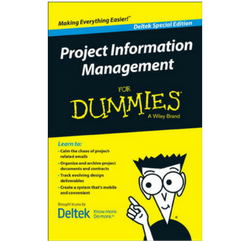
What is PIM? A Project Information Management (PIM) strategy and system does exactly what the name implies, it offers an efficient and easy way of managing your project information. Your PIM strategy can, and should, cover all of the information created and shared as part of your projects. Whether you are an architect, engineer, construction consultant or contractor, having PIM in place will assist in the smooth running of your projects.
What Information Does PIM Help You To Manage?
Tweet it: 'What is PIM and why do you need it?'
1. Emails And Attachments
Emails relating to your projects should be treated with the same level of importance as other project documentation, such as RFIs, drawings and diagrams and contracts. PIM allows you to file, store and retrieve emails and their attachments easily, reducing the risk of losing critical information.
2. Documents
With projects becoming more complex, the amount of documentation that needs to be produced and managed has increased. Implementing PIM, including a single point of storage, automated reference numbers, version control and auditing procedures will make the sharing and management of project documentation easier and more efficient.

3. Design Deliverables
Your design deliverables are a key part of any construction project. Creating a document register and processes to manage how design deliverables are reviewed, edited and transmitted will help to keep your project on track.
4. Contracts
Use PIM to keep accurate records of information, contract changes and financial certification. What used to be a long winded process, involving reams of paper, is now automated and allows for instant feedback and approval, reducing the amount of time and work involved considerably.
Why Do You Need A PIM Strategy And System?
Information is central to the success of project-based work, yet many organisations fail to establish processes that support project teams with the management of this information. Every project is unique but one thing that they do have in common is the requirement to produce, manage, review and share information and documentation..
Some of this information could be seen as more important, contractual documentation and drawings for example, but all of it contributes to the successful management of your projects.
How Can A PIM Strategy And System Help?
- Single document register to file and store your information
- Filing and naming conventions that support the way you manage your projects
- Version control and easy to find document references, ensuring that everyone is working off the right version of the contract, drawing or document
- Ability to file email communications and attachments as most project information is distributed this way
- Automation of document review, sign off and filing
- Ability to set permissions and control how information and documentation is distributed - Set actions against documents, drawings and contracts so that deadlines aren’t missed.
Understanding Project Information Management - An Introduction Series
- 5 Reasons Why Your AEC Firm Needs Project Information Management
- 4 Types Of Project Information You Should Use PIM Software To Manage
- Project Information Management is changing the AEC Industry
- Managing Multiple Projects? Here Are 6 Ways To Ensure You Master Email Management
- The Fundamentals Of Managing Design Deliverables
- How Mobile Working Can Benefit Your Construction Firm

Deltek Project Nation Newsletter
Subscribe to receive the latest news and best practices across a range of relevant topics and industries.



